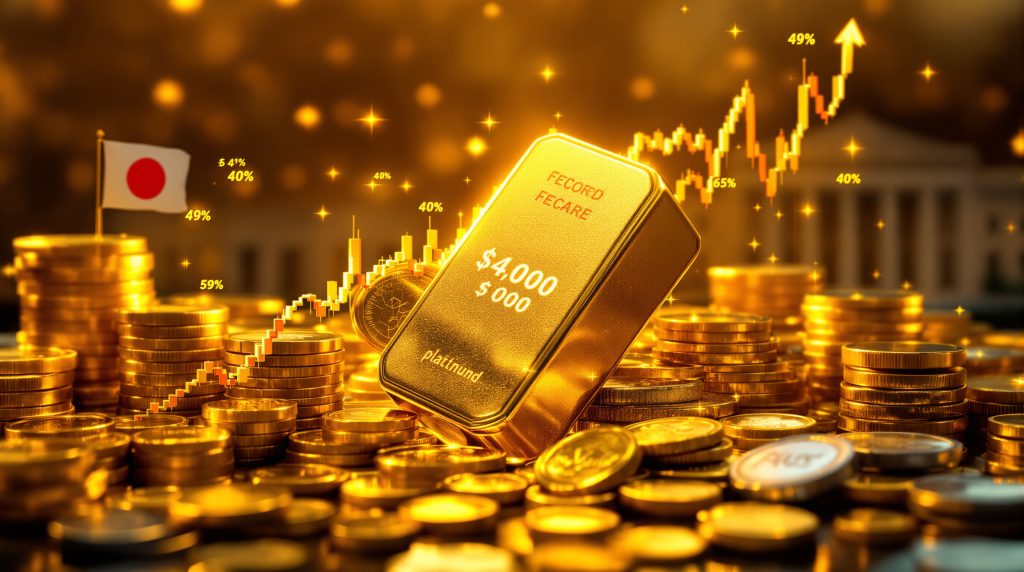Understanding the Gold Price Surge: Why Precious Metals Are Breaking Records
The $2,800 Milestone: Understanding the Context
Gold has reached unprecedented heights in late 2024, surpassing $2,700-$2,800 per ounce according to the London Bullion Market Association. This represents a remarkable 27% increase in 2024 alone, marking one of the strongest annual performances for the precious metal in recent years.
The current price trajectory demonstrates accelerating momentum throughout 2024, with multiple resistance levels being broken with minimal pullbacks. These price levels reflect a fundamental shift in global investment patterns as investors increasingly turn to tangible assets during uncertain economic times.
Historical context: The gold market has experienced several notable rallies over the past decades, but the current record price surge stands out for its strength and sustainability across multiple economic conditions.
Global Economic Uncertainty as a Primary Catalyst
Economic uncertainty has emerged as a significant driver behind gold's remarkable performance. Geopolitical tensions, trade disputes, and concerns about economic stability have all contributed to heightened market anxiety.
According to JPMorgan's commodity research team, these tensions continue to support gold as a safe-haven asset, with investors seeking protection from market volatility and currency devaluation risks.
Market concerns about potential GDP impacts from policy decisions have directed significant capital toward traditional safe havens. As one commodity strategist at Bank of America noted, "When economic data becomes increasingly unpredictable, gold typically benefits from the flight to safety."
Economic information gaps created by delayed data releases have further amplified uncertainty, creating an environment where investors favor assets with intrinsic value over those dependent on economic forecasts.
Monetary Policy Shifts Fueling the Rally
The Federal Reserve's recent 25 basis point rate cut in September 2024, moving the federal funds rate to 5.00%-5.25%, has provided immediate support for gold prices. This policy shift represents a significant pivot after a prolonged tightening cycle.
Market expectations now indicate high probability of continued rate cuts through the remainder of 2024, creating an increasingly favorable environment for gold:
- Lower interest rates reduce the opportunity cost of holding non-yielding assets like gold
- The inverse relationship between interest rates and gold prices is well-documented in financial literature
- As rates decline, gold becomes more attractive compared to interest-bearing securities
Goldman Sachs analysts noted in their December 2024 report that this changing interest rate landscape fundamentally supports higher gold prices in the medium term, as the opportunity cost of holding gold diminishes significantly.
How Are Global Factors Influencing Gold's Performance?
Japanese Currency Effects and Global Implications
The Japanese yen has experienced significant volatility against the USD throughout 2024, influenced by Bank of Japan policy decisions. This currency movement has important implications for gold:
- Reduced availability of yen as an alternative safe-haven asset directs capital flows to gold
- Currency market volatility creates additional incentives for diversification into precious metals
- International investors increasingly view gold as a more stable store of value than many currencies
This currency dynamic has particularly impacted Asian markets, where gold has traditionally played an important cultural and investment role. The weakening yen has contributed to stronger gold demand across the region as investors seek alternatives.
Central Bank Purchasing Patterns
Central bank gold purchases have formed a critical foundation for price support. According to the World Gold Council, central bank purchases totaled 1,037 tonnes in 2023, the second-highest annual total on record.
This sustained buying reflects strategic diversification away from traditional reserve currencies:
- People's Bank of China added 225 tonnes to reserves in 2023
- Turkey's central bank purchased 45 tonnes in 2023
- Poland increased gold reserves by 35 tonnes in 2023
Emerging market central banks have been particularly active in accumulating gold reserves, with collective purchases reaching record levels. This reflects both diversification strategies and concerns about traditional reserve currency stability.
A critical insight often overlooked is that BRICS nations (Brazil, Russia, India, China, and South Africa) have been systematically increasing their gold holdings as part of a broader strategy to reduce dependence on the US dollar in international transactions.
Investment Vehicle Dynamics
Strong demand for gold-backed exchange-traded funds (ETFs) has been a significant market driver. Global gold ETF holdings reached approximately 3,100 tonnes as of Q3 2024, according to World Gold Council data.
This trend highlights several important market developments:
- Retail investor participation has increased significantly
- Institutional allocation models have adjusted to include higher gold percentages
- Portfolio diversification strategies increasingly emphasize precious metals exposure
The accessibility of gold through ETFs has democratized gold investing, allowing smaller investors to gain exposure without the complexities of physical ownership. This broadened investor base provides additional support for sustained price levels.
What Are the Technical and Market Indicators Suggesting?
Price Movement Analysis
Gold's technical indicators have consistently signaled bullish sentiment throughout 2024. Key patterns include:
- Breaking through multiple resistance levels with minimal pullbacks
- Trading volumes supporting the upward momentum
- Price discovery occurring in previously uncharted territory
Technical analysts at major financial institutions have noted that gold's pattern of consolidation followed by breakouts has created a strong foundation for continued upward movement. This pattern suggests sustained investor confidence rather than speculative excess.
One uniquely valuable insight from technical perspective is that gold's current rally differs significantly from previous bull markets in its pattern of consolidation periods followed by measured advances, rather than parabolic price movements that typically precede major corrections.
Market Sentiment Metrics
Broker outlooks have grown increasingly bullish on gold's continued rally potential. Major financial institutions have revised their price forecast insights upward multiple times throughout 2024, reflecting changing market conditions.
Investor positioning indicates confidence in further upside:
- Commercial futures traders have reduced short positions
- Speculative long positions have increased but remain below historical extremes
- Option market activity shows increasing interest in upside protection
This positioning data suggests the rally has room to continue without immediate concerns of excessive speculation. The gradual nature of position building indicates sustainable interest rather than frenzied buying.
Psychological Price Thresholds
The proximity to significant psychological price levels creates additional market dynamics. Historical precedent shows that major round-number thresholds often act as both resistance and, once broken, accelerated momentum points.
Media coverage intensifies around these levels, potentially attracting new investor interest. According to recent market analysis, financial journalists have increasingly featured gold in headline stories, bringing additional attention to the market from mainstream investors.
A particularly insightful observation from veteran gold traders is that psychological resistance levels in gold often behave differently than in other markets—once breached, they frequently trigger stronger-than-expected follow-through buying rather than the typical "sell the breakout" pattern seen in many financial assets.
How Are Other Precious Metals Performing in This Environment?
Silver's Parallel Rally
Silver prices reached approximately $32-35 per ounce in late 2024, according to the London Bullion Market Association. This represents significant outperformance compared to historical patterns.
The gold-to-silver ratio averaged approximately 80:1 in 2024 (World Gold Council), but has been trending lower as silver gains momentum. This ratio movement is significant:
- Historically, a declining ratio often indicates a healthy precious metals bull market
- Industrial silver demand creates different dynamics than purely investment-driven gold
- The dual nature of silver as both precious and industrial metal adds complexity
According to the Silver Institute, solar panel silver demand increased 15% in 2023, highlighting the growing industrial applications supporting price levels. This industrial component provides an additional demand driver not present with gold.
Platinum Group Metals Performance
Platinum traded around $1,000-1,100 per ounce in Q4 2024, according to Johnson Matthey's 2024 market reports. This performance reflects complex supply and demand factors:
- Automotive sector transitions affecting traditional platinum demand
- Mining supply constraints in South Africa impacting availability
- Growing interest in platinum as an alternative to gold at lower price points
A critical insight from industry specialists is that platinum group metals are experiencing significant supply constraints due to deepening mining challenges in South Africa, where approximately 70% of global platinum production occurs. Power supply issues and labor concerns have restricted output below market expectations.
Johnson Matthey's PGM Market Report (2024) noted that automotive industry platinum demand decreased 2% in 2023 due to the electric vehicle transition. However, this decline has been partially offset by increased industrial applications and investment demand.
What Are the Implications for Investors and Global Markets?
Portfolio Diversification Considerations
Traditional 60/40 stock/bond allocations are being reconsidered in light of gold's performance and changing market conditions. Research by Erb & Harvey (Financial Analysts Journal, 2013) suggests optimal gold allocation of 2-10% in diversified portfolios.
Vanguard's 2024 economic outlook noted gold's inflation hedge role and portfolio diversifier. Their analysis highlights several key considerations:
- Correlation benefits during periods of market stress
- Long-term performance metrics against inflation
- Historical behavior during currency devaluation periods
Gold's correlation with the S&P 500 has averaged -0.1 over the past 20 years, according to data from the Federal Reserve Bank of St. Louis (2024). This low correlation makes gold particularly valuable as a diversification tool in balanced portfolios.
During market stress periods, gold's correlation with equities often becomes more negative, according to research from the Bank for International Settlements (2023). This pattern enhances its value as a portfolio stabilizer during turbulent market conditions.
Consumer and Retail Market Impact
Jewelry pricing dynamics have shifted globally in response to higher gold prices. Traditional gold-consuming cultures have adapted their purchasing patterns:
- Shift toward lower carat items in price-sensitive markets
- Increased interest in gold investment products over purely decorative items
- Growing secondary market activity for existing gold holdings
Cultural buying patterns continue to evolve, particularly in markets like India and China where gold holds both cultural and investment significance. As reported by The Economic Times, the adjustment to higher price levels has been gradual but persistent.
Macroeconomic Significance
Gold prices serve as an important barometer of economic confidence and inflation expectations. Central banks closely monitor gold markets for signals about:
- Market perceptions of monetary policy effectiveness
- Long-term inflation expectations
- Currency valuation pressures
- Global economic stability concerns
The sustained gold price surge suggests persistent concerns about fiat currency stability and long-term inflation risks, despite official inflation metrics showing moderation in many economies.
What Could Change the Current Gold Price Trajectory?
Potential Headwinds for Gold
Several factors could potentially moderate gold's price momentum:
- A shift to more hawkish monetary policy from major central banks
- Strengthening of alternative safe-haven currencies
- Significant improvement in global geopolitical tensions
- Resolution of major trade disputes affecting global growth
The Federal Reserve's policy normalization timeline, as discussed in recent Federal Open Market Committee minutes (2024), remains a key variable. Any indication of slower rate cuts or policy reversal could impact gold's appeal.
A particular insight rarely discussed outside specialist circles is that rising real yields (interest rates adjusted for inflation) historically show a stronger inverse relationship with gold prices than nominal rates alone. This relationship could become increasingly important if inflation expectations shift significantly.
Long-Term Sustainability Factors
Mining production constraints create supply-side support for gold prices. Major producers have reported declining ore grades and increasing extraction costs:
- Environmental regulations affecting new mine development
- Resource nationalism in key producing regions
- Rising energy costs impacting production economics
The UN Environment Programme's 2024 report on mining highlighted increasing regulatory pressures facing gold producers. These constraints suggest potential long-term supply limitations that could support prices.
Technological developments in recycling and recovery present both opportunities and challenges for the gold market. Advances in urban mining (recovering gold from electronic waste) have improved but still represent a small percentage of total supply.
FAQs About the Gold Price Surge
Why is gold considered a safe-haven asset during economic uncertainty?
Gold has maintained its value throughout centuries of economic systems, offering a store of value independent of government currencies. During periods of uncertainty, investors seek assets with intrinsic value that aren't directly tied to economic performance or subject to counterparty risk.
Unlike paper assets, gold cannot be devalued through monetary policy decisions. Its limited supply, durability, and universal recognition make it particularly attractive when confidence in financial systems or currencies is questioned.
How do interest rates affect gold prices?
Lower interest rates reduce the opportunity cost of holding non-yielding assets like gold. When rates fall, the interest income foregone by holding gold instead of interest-bearing securities decreases, making gold relatively more attractive to investors.
The inverse relationship between interest rates and gold prices is well-documented in academic literature (Baur & Lucey, Journal of Banking & Finance, 2010). This relationship explains why gold often performs strongly during periods of monetary easing.
What role do central banks play in the gold market?
Central banks are significant participants in the gold market, collectively holding approximately 35,000 tonnes. Their purchasing decisions can substantially impact prices, creating a fundamental demand floor.
Recent years have seen increased buying from emerging market central banks seeking to diversify reserves away from dominant currencies. This trend represents a structural shift in the market rather than cyclical behavior, suggesting sustained support for prices.
How might elections and policy changes impact gold prices?
Elections typically introduce policy uncertainty that can benefit safe-haven assets. Potential changes in fiscal policy, regulatory approaches, and international relations following elections could influence investor sentiment toward gold.
Historical data shows gold often experiences increased volatility during major election cycles, reflecting heightened uncertainty about future economic conditions and policy directions.
Is the current gold price surge creating a bubble?
While prices have risen substantially, fundamental factors including monetary policy, economic uncertainty, and sustained central bank buying provide underlying support. Unlike speculative bubbles characterized by retail investor mania, the current rally includes substantial institutional participation and diverse demand sources.
Market indicators suggest measured enthusiasm rather than excessive speculation, with positioning data showing room for additional participation before reaching extreme levels associated with market tops.
Geological and Supply Factors Affecting Gold Markets
Mining Challenges and Production Realities
Gold mining faces increasing challenges that impact long-term supply outlooks:
- Average ore grades globally have declined from approximately 2.0 g/t in 2000 to below 1.0 g/t today
- New discoveries have decreased significantly despite increased exploration spending
- The time from discovery to production has extended to 10-20 years for major projects
These geological realities create natural constraints on supply expansion, even during periods of higher prices. The finite nature of gold resources means production cannot simply increase in response to demand.
Environmental and Regulatory Considerations
Environmental regulations have significantly impacted gold mining operations worldwide:
- Water usage restrictions affect processing capabilities
- Carbon emissions reduction targets increase operating costs
- Land use limitations restrict access to potential resources
The increasing focus on environmental, social, and governance (ESG) factors has transformed operating practices, with higher compliance costs becoming a permanent feature of gold production economics.
Technological Innovation in the Gold Industry
Advancements in mining and processing technology continue to evolve:
- Automated mining equipment improving operational efficiency
- Advanced processing methods reducing environmental impacts
- Blockchain-based supply chain tracking enhancing transparency
These technological developments help mitigate some production challenges but haven't fundamentally altered the supply constraints facing the industry.
In conclusion, gold's recent price performance reflects a complex interaction of macroeconomic, geopolitical, and supply-demand factors. While the precious metal has demonstrated remarkable strength, investors should maintain awareness of both supporting fundamentals and potential risks when considering gold price analysis and investment strategies as part of their investment approach.
Want to Catch the Next Major ASX Mining Discovery?
Discovery Alert's proprietary Discovery IQ model identifies significant ASX mineral discoveries in real-time, transforming complex data into actionable investment insights before the broader market recognises the opportunity. Explore how major discoveries can generate substantial returns by visiting Discovery Alert's dedicated discoveries page and position yourself for potential gold-rush style returns.




